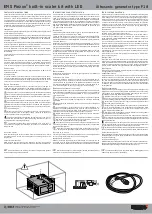
Symptom
Possible cause
Test
Solution
Motor is
running in
wrong
direction
Motor rotation limit is not
programmed correctly.
Check that
parameter 4-10 Motor Speed Direction
is
programmed correctly.
Program the correct settings.
Active reversing signal is
programmed.
Check if a reversing command is programmed for the
terminal in
parameter group 5-1* Digital inputs
.
Deactivate the reversing signal.
Wrong motor phase
connection.
Change the direction of rotation
by switching 2 phases in the
motor cable, or by changing the
setting of
parameter 4-10 Motor
Speed Direction
.
Motor is not
reaching
maximum
speed
Frequency limits are set
incorrectly.
Check output limits in
parameter 4-13 Motor Speed
High Limit [RPM]
,
parameter 4-14 Motor Speed High
Limit [Hz]
, and
parameter 4-19 Max Output Frequency
.
Program the correct limits.
Reference input signal is not
scaled correctly.
Check reference input signal scaling in
parameter
group 6-0* Analog I/O Mode
and
3-1* References
.
Reference limits in
parameter group
3-0* Reference
Limit
.
Program the correct settings.
Motor speed
is unstable
Possible incorrect parameter
settings.
Check the settings of all motor parameters, including
all motor compensation settings. For closed-loop
operation, check PID settings.
Check the settings in
parameter
group 1-6* Load Depen.Setting
. For
closed-loop operation, check the
settings in
parameter group 20-0*
Feedback
.
Motor runs
rough
Possible overmagnetization.
Check for incorrect motor settings in all motor
parameters.
Check the motor settings in
parameter groups
1-2* Motor Data,
1-3* Adv Motor Data
, and
1-5*
Load Indep. Setting
.
Motor does
not brake
Possibly incorrect settings in
the brake parameters. Possibly
ramp-down times are too short.
Check brake parameters. Check ramp-time settings.
Check
parameter groups
2-0* DC
Brake
and
3-0* Reference Limits
.
Open power
fuses or
tripped circuit
breaker
Phase-to-phase short.
Motor or panel has a short circuit, phase-to-phase.
Check motor and panel phase for short circuits.
Eliminate any detected short
circuits.
Motor overload.
Motor is overloaded for the application.
Perform the startup test and
verify that motor current is within
specifications. If motor current
exceeds the nameplate full load
current, the motor runs only with
reduced load. Review the specifi-
cations for the application.
Loose connections.
Perform a pre-startup check for loose connections.
Tighten any loose connections.
Mains current
imbalance is
greater than
3%
Problem with mains power (See
alarm 4, Mains phase loss
description).
Rotate the input power leads into the drive system 1
position: A to B, B to C, and C to A.
If the imbalanced leg stays on
the same power lead, it is a
power problem. Check the mains
supply.
Problem with the drive system. Rotate the input power leads into the drive system 1
position: A to B, B to C, and C to A.
If the imbalanced leg stays on
the same input terminal, the
problem is in the unit. Contact a
Danfoss supplier.
Motor current
imbalance is
greater than
3%
Problem with the motor or
motor wiring.
Rotate the output motor cables 1 position: U to V, V
to W, and W to U.
If the imbalanced leg stays on
the same output motor cable, the
problem is in the motor or motor
wiring. Check the motor and
motor wiring.
Problem with the drive system. Rotate the output motor cables 1 position: U to V, V
to W, and W to U.
If the imbalanced leg stays on
the same output terminal, the
problem is with the unit. Contact
a Danfoss supplier.
Maintenance, Diagnostics, a...
User Guide
MG37L202
Danfoss A/S © 08/2017 All rights reserved.
49
6
6
















































